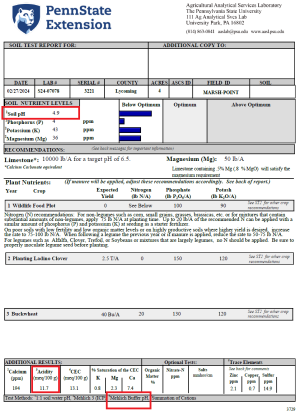RGrizzzz
Administrator
Curious for the hive mind feedback. We acquired the neighbors property in the winter. There is about 5 acres of open field on the hillside. We soiled tested and the pH is low, which is also confirmed by looking at what little is growing there. What are your thoughts on kick starting this plot? Should we open it up and plant something, or wait until we can get it limed? Partially or totally?
We can get our tractor to it across the creek, but getting lime there is more of a challenge. Local suppliers won't cross the creek, even though it might only be 12" deep. We don't have a bridge yet. Timeline is "hopefully this summer" but we're shooting for something to drive UTVs across, not 20 tons of lime. We can dump the lime across the creek, load with the tractor, spread with the UTV(s) and repeat. We currently only have a 500 lb capacity Groundbuster. Renting a second might be a wise move for a weekend to speed things up. As you can see, it needs a lot of lime. Should we bother putting in some buckwheat this summer, or leave it until we can get the lime down and mixed in?
View attachment 63758
We can get our tractor to it across the creek, but getting lime there is more of a challenge. Local suppliers won't cross the creek, even though it might only be 12" deep. We don't have a bridge yet. Timeline is "hopefully this summer" but we're shooting for something to drive UTVs across, not 20 tons of lime. We can dump the lime across the creek, load with the tractor, spread with the UTV(s) and repeat. We currently only have a 500 lb capacity Groundbuster. Renting a second might be a wise move for a weekend to speed things up. As you can see, it needs a lot of lime. Should we bother putting in some buckwheat this summer, or leave it until we can get the lime down and mixed in?
View attachment 63758
Last edited:



